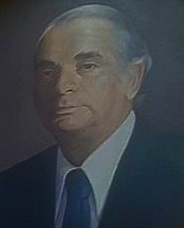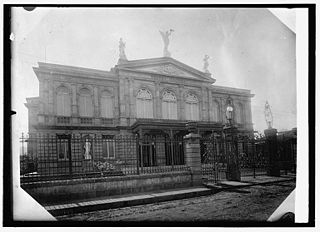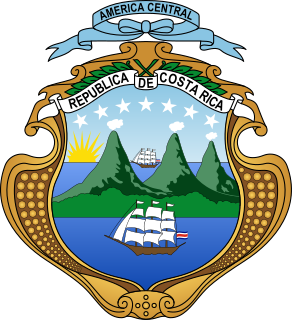
Porfirio Ricardo José Luis Daniel Oduber Quirós was a Costa Rican politician, lawyer, philosopher, poet, and essayist. He served as the President of Costa Rica from 1974 to 1978. He is credited with the creation of the Sistema Nacional de Radio y Televisión and the Universidad Estatal a Distancia.

Francisco José Orlich Bolmarcich is 34th President of Costa Rica from 1962 to 1966. His grandfather on the Orlich side and his mother came to Costa Rica from the town of Punat on the island of Krk, Croatia. His villa in Punat is named "Villa Costarica".

León Cortés Castro was a Costa Rican politician. He served as President of Costa Rica from 1936 to 1940. During his term he introduced new bank reforms, supported banana plantations in the South Pacific region, and established ports at Quepos and Golfito. His administration is often referred to as the "iron bars and cement administration" because of the various construction projects undertaken during his presidency, including the construction of the former International Airport of La Sabana. He was the last of a series of relatively conservative Presidents. He considered changes to allow him to pursue re-election as President, but ultimately backed down due to a Constitutional ban on consecutive terms. He was succeeded by Rafael Ángel Calderón Guardia, who ultimately broke with tradition and substantially increased the scope of the social state.

Romualdo Ricardo Jiménez Oreamuno served as president of Costa Rica on three separate occasions: 1910 to 1914, 1924 to 1928, and 1932 to 1936.

Juan Bautista Quirós Segura was president of Costa Rica for two weeks, from August 12 to September 2, 1919, following the resignation of Federico Tinoco. His government was not recognized by the United States and he was forced to resign.

José María Castro Madriz was a Costa Rican lawyer, academic, diplomat, and politician. He served twice as President of Costa Rica, from 1847 to 1849, and from 1866 to 1868. On both occasions he was prevented from completing his term of office by military coups. During his first administration, on 31 August 1848, he formally declared Costa Rica an independent republic, definitively severing Costa Rica's ties to the moribund Federal Republic of Central America.

Alajuela is the second largest city in Costa Rica. It is also the capital of Alajuela Province.
The Costa Rican Civil War was the bloodiest event in 20th-century Costa Rican history. It lasted for 44 days, during which approximately 2,000 people are believed to have died. The conflict was precipitated by the vote of the Costa Rican Legislature, dominated by pro-government representatives, to annul the results of the presidential elections held in February, alleging that the triumph of opposition candidate Otilio Ulate had been achieved by fraud.

The Roman Catholic Archdiocese of San José de Costa Rica is a Metropolitan Archdiocese and its suffragan dioceses are Alajuela, Cartago, Ciudad Quesada, Limón, Puntarenas, San Isidro de El General and Tilarán. The see was elevated to an archdiocese on 16 February 1921.

Carmen Lyra was the pseudonym of the first prominent female Costa Rican writer, born Maria Isabel Carvajal Quesada. She was a teacher and founder of the country's first Montessori school. She was a co-founder of the Communist Party of Costa Rica, as well as one of the country's first female worker's unions. She was one of the earliest writers to criticize the dominance of the fruit companies. She won many prizes.
Gerardo Guzmán Quirós was a Costa Rican politician.
Benito Serrano Jiménez was a Costa Rican politician and judge.
Jorge Volio Jiménez was a Costa Rican priest, soldier and politician.

The following is an alphabetical list of topics related to the Republic of Costa Rica.
Costa Rican literature has roots in colonization and is marked by European influences. Because Costa Rica is a young country, its literary tradition is also young. The history of Costa Rican literature dates to the end of the 19th century.
Costa Rica became a member of the United Nations on February 11, 1945.
Nidia María Jiménez Vásquez is a Costa Rican educator and politician, serving as a deputy in the Legislative Assembly of Costa Rica for the 2014 to 2018 term. She is a member of the Citizens' Action Party.
Henry Mora Jiménez is a Costa Rican economist and political activist. Mora is a member of the 2014-2018 Legislative Assembly of Costa Rica, serving with the Citizens' Action Party. He was the President of the Legislative Assembly of Costa Rica from 2014 to 2015.
Marjorie Elliott Sypher de Oduber was a Canadian-born Costa Rican musician and public figure. She served as the First Lady of Costa Rica from 1974 to 1978 during the administration of her husband, former President Daniel Oduber Quirós.

It is known as the Liberal State the historical period in Costa Rica that occurred approximately between 1870 and 1940. It responded to the hegemonic dominion in the political, ideological and economic aspects of liberal philosophy. It is considered a period of transcendental importance in Costa Rican history, as it's when the consolidation of the National State and its institutions finally takes place.














